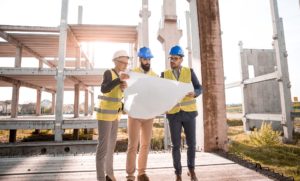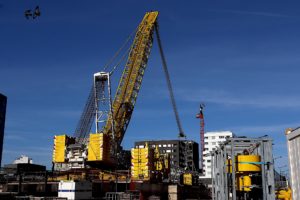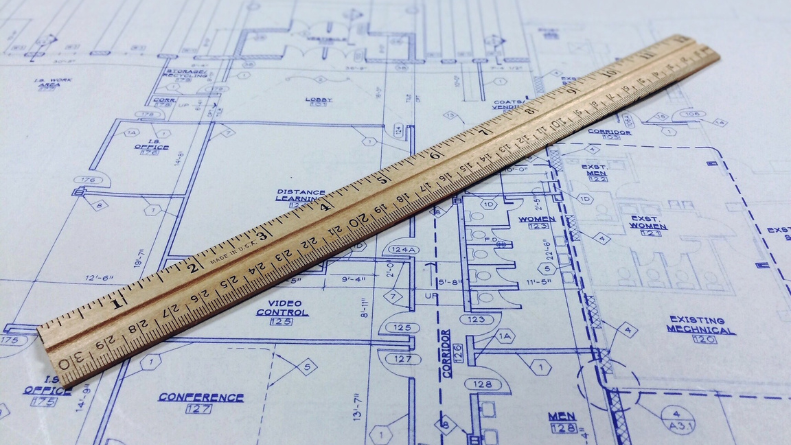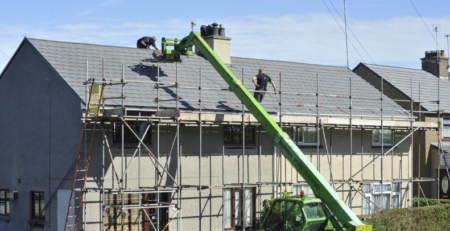Converting Commercial Properties into Residential Spaces
Have you ever caught yourself staring at an old, deserted commercial property and pictured it transformed into a stylish residential sanctuary? This imaginative leap is not just a daydream; it’s a growing movement within the UK’s property landscape. Stepping into the realm of converting commercial properties into residential spaces is an adventure filled with unique challenges and rich rewards. This guide takes you through the journey from the historical roots of this trend, through its evolution, to the current surge driven by our changing work and shopping patterns. Dive into the intricate details of why converting properties is not only financially appealing but also a socially responsible endeavour.
The Backstory of Building Reimaginations
The tale of transforming commercial spaces into homes is woven into the fabric of the UK’s urban development history. Gaining momentum in the twilight of the 20th century, this movement found its champions among visionary developers. Cities like London and Manchester, with their abandoned industrial buildings, served as fertile ground for these pioneers. These structures, often located in coveted urban centres, provided the perfect backdrop for unique and attractive residential creations, blending the charm of the past with the comfort and convenience of modern living.
Legislative Landmarks: Clearing the Path for Conversions
The dawn of the 21st century brought with it a pivotal moment for property conversions in the UK. Recognizing the potential to alleviate the growing housing shortage, the government took proactive steps to encourage the creative repurposing of commercial spaces. The watershed moment came in 2013 with the introduction of new planning regulations. These changes significantly streamlined the conversion process, making it easier and more attractive for property developers to transition commercial buildings into residential use, thereby sparking a conversion boom.
The Conversion Craze: A Contemporary Movement
The last few years have seen an intensification of interest in property conversions, propelled by significant shifts in our working and shopping habits. The rise of remote work and the dominance of online shopping have reduced the need for physical office and retail spaces, leaving many such properties empty. These underutilized spaces are now prime targets for transformation into residential units, marking a contemporary surge in the conversion movement.

The Financial Upside of Urban Renewals
Jamie Johnson, CEO of FJP Investment, captures the essence of this trend: “Converting commercial properties into residential spaces isn’t just about making a profit; it’s about recognising and unlocking the latent value within our urban landscapes.” This conversion process presents a mutually beneficial scenario. Property owners stand to gain from potentially higher returns on investment compared to traditional commercial rentals, with the added advantage of various financial incentives bolstering the appeal of such projects.
A Concrete Solution to the Housing Crisis
The UK is facing a critical housing shortage, a challenge that can be partially addressed by the imaginative repurposing of commercial spaces. This strategy not only provides much-needed residential units but does so in an environmentally and economically efficient manner, utilizing existing structures instead of resorting to new constructions.
Community Catalysts: The Revitalisation Ripple Effect
The conversion of commercial properties into residential spaces often serves as a catalyst for the rejuvenation of neighbourhoods. Introducing residential life into previously dormant areas can breathe new life into communities, sparking the development of local amenities such as cafes, parks, and retail shops. This revitalization enhances the overall quality of life for residents, creating vibrant, thriving neighbourhoods.
Green Gains: The Environmental Advantage
One of the most compelling arguments for property conversion is its sustainability. Repurposing existing buildings is inherently more environmentally friendly than constructing new ones, reducing the demand for raw materials and minimizing construction-related pollution. Furthermore, many conversion projects prioritize eco-friendly designs and features, contributing to a more sustainable urban landscape and marking a significant step towards greener living solutions.

Navigating the Conversion Course
Embarking on the transformation of commercial properties into residential spaces is akin to setting sail on uncharted waters. The journey, while rewarding, is dotted with regulatory icebergs, financial storms, and operational whirlpools. Let’s chart a course through these turbulent seas, ensuring your voyage from concept to completion is as smooth as possible.
The Red Tape Maze: Regulatory Realities
Venturing from commercial realms into residential territories is not for the faint-hearted. The path is strewn with a complex web of planning permissions and building regulations. Each step forward requires careful navigation to sidestep potential pitfalls that could not only delay but also derail your ambitious project. It’s about more than crossing Ts and dotting Is; it’s a deep dive into the legal intricacies that dictate what can and cannot be done with a property.
Understanding the zoning laws, building codes, and other local regulations is imperative. These rules vary widely across different councils, each with its own set of expectations and requirements. Some areas might be welcoming of residential conversions, seeing them as vital to revitalising neighbourhoods. Others may impose strict limitations, protecting the area’s commercial integrity or historical significance. Engaging with these regulations early on, possibly with the help of a seasoned planning consultant, can illuminate the path forward and help avoid costly detours.
Budgeting Beyond the Blueprint
Anyone who’s dabbled in property development knows that initial budget estimates are just the starting point. Conversion projects, with their potential for unexpected structural surprises, are particularly prone to cost overruns. It’s not uncommon for hidden issues to emerge once work begins, from outdated wiring needing an overhaul to structural weaknesses demanding reinforcement.
Building a financial cushion is crucial. This buffer accounts for the unforeseen, ensuring that your project doesn’t grind to a halt when faced with the inevitable surprises. Additionally, investigating potential grants, tax incentives, or other financial aids early in the planning stage can provide a lifeline, making your budget stretch further and your project more viable.
Assessing Appetite and Avoiding Oversupply
One of the cardinal rules of property conversion is understanding the market demand. It’s a delicate balance between supply and demand. Launching into a conversion without a clear grasp of the local appetite for residential units can lead to an oversupply, potentially stifling the project’s success before it even begins.
Market research is your compass here, guiding decisions about the size, type, and price point of your residential units. Factors such as local demographics, employment rates, and existing housing stock play a significant role in shaping demand. A thorough analysis not only validates the project’s potential but also tailors it to meet the specific needs of the target market, ensuring the finished product is both desirable and viable.
Overcoming Operational Obstacles
The actual conversion process, turning commercial spaces into habitable homes, is a feat of engineering and design. It often involves significant structural changes – from adding kitchens and bathrooms to reconfiguring layouts for residential living. The complexity of these alterations necessitates a team of experts, each bringing their own skill set to the table.
Assembling a dream team of architects, builders, and engineers familiar with the unique challenges of conversions is vital. Their expertise can transform potential obstacles into opportunities, ensuring the project not only meets but exceeds expectations. Collaboration and communication among team members are key to navigating this phase effectively, turning conceptual designs into a living, breathing community.

From Concept to Completion: A Guide for the Prospective Converter
A property conversion project is a journey of transformation. It’s about turning the old into something new and vibrant. To navigate this path successfully, a comprehensive approach, from initial assessment to final design, is essential.
Viability Verifications: Laying the Groundwork
The first step in any conversion project is to determine its feasibility. This involves a meticulous assessment of the property’s location, structural condition, and suitability for residential use. Consideration of the local housing market’s dynamics, including demand for residential spaces and the area’s demographic profile, is also crucial.
A detailed inspection of the building can uncover potential challenges, from structural issues to environmental concerns, shaping the project’s scope and budget. Understanding these factors upfront can guide decision-making, ensuring the project’s viability and success.
Legality and Logistics
Familiarizing yourself with the local planning and building regulations early in the process is crucial for a smooth journey. Engaging with local authorities, perhaps through pre-application discussions, can offer insights into potential hurdles and how to overcome them.
This phase might involve securing the necessary permits, understanding the impact of building codes on your project, and aligning your plans with local development strategies. It’s about laying a solid legal and logistical foundation for the project, ensuring compliance and minimizing delays.
Budget Breakdowns
A detailed and realistic budget is the cornerstone of any successful conversion project. This includes not only the obvious costs, such as purchasing the property and the initial renovations but also less visible expenses like legal fees, insurance, and contingency funds for unexpected challenges.
Exploring financing options early on, from traditional loans to government grants or private investment, can provide the necessary capital to bring your vision to life. A clear financial plan, backed by thorough research and prudent forecasting, ensures the project remains on solid footing from start to finish.
Assembling Your Conversion Crew
No conversion project succeeds in a vacuum. It requires the collaboration of a diverse group of professionals, from architects and engineers to builders and interior designers. Each brings a unique perspective and expertise, crucial for overcoming the specific challenges of converting commercial spaces into residential havens.
Selecting the right team is about more than checking credentials. It’s about finding partners who share your vision and commitment to quality. Their collective experience in similar projects can be invaluable, turning potential pitfalls into innovative solutions.

Design Decisions: Crafting for the Consumer
Designing with the end-user in mind is key to the project’s success. This means considering the needs and preferences of the future residents, whether they’re young professionals, families, or retirees. The design should reflect the target demographic’s lifestyle, from the layout and features to the choice of materials and finishes.
Flexibility in design can also be advantageous, allowing spaces to adapt to changing needs over time. This forward-thinking approach ensures the project remains relevant and appealing to residents for years to come.
Adaptability in Action: Expecting the Unexpected
Finally, the ability to adapt is perhaps the most crucial skill in the converter’s toolkit. Conversion projects, with their inherent uncertainties and surprises, demand flexibility and resilience. Being prepared to adjust plans, budgets, and timelines in response to unforeseen challenges is essential.
This adaptability not only helps navigate the project through rough waters but also ensures that the final product is not just a reflection of the initial vision but an improved realization of it. With a flexible approach, each challenge becomes an opportunity for innovation, ensuring the project’s success and longevity.
Navigating the conversion course from commercial to residential is a journey fraught with challenges but rich with rewards. With careful planning, a deep understanding of the market, and a commitment to quality and sustainability, converters can transform underutilized spaces into vibrant, thriving communities.
Conclusion
Converting commercial properties into residential spaces is more than a mere trend; it’s a strategic response to the changing dynamics of our cities and a testament to the innovative spirit of the UK’s property developers. Whether driven by the allure of financial returns, the desire to contribute to solving the housing crisis, or the ambition to revitalise communities, the journey from commercial to residential is fraught with challenges but ripe with opportunity. With careful planning, a clear understanding of the regulatory landscape, and a commitment to sustainable development, these projects can transform not just buildings but entire neighbourhoods, creating vibrant, sustainable communities for future generations.
ARE YOU READY TO START INVESTING?
Subscribe to our mailing list now for exclusive deals, investment guides and the latest information from the property market.







